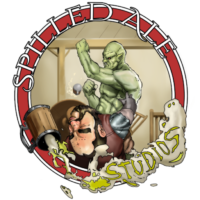Today’s blog post is for fans of Fifth Edition Fallout! I’ve received a few suggestions and questions since I first released the rules, and I thought I’d compile my answers here.
Characters
If your player wants to be a ghoul who’s only recently turned and doesn’t have the years of life experience that the +2 Intelligence is supposed to represent, consider just flipping the bonus: +2 Con, +1 Int.
Equipment
- I don’t consider it a high priority as there’s a very good weapon selection already.
- One issue is how to integrate them with the Fallout 4 style modification system. Adding weapons from older games leaves me in the position of deciding for myself what modifications that weapon can have. That’s why so far I’ve only added the .357 revolver (which was easy to rule as having similar modification access to the .45 revolver) and the K-9000 (a unique heavy weapon with no modifications).
Armour: No plans to add more. The piecemeal armour system is deliberately generic so you can describe your light, medium, and heavy armour pieces as whatever you want them to be. I’m fairly confident that all canonical power armours are also represented when you factor in the available modifications. If I’m wrong, do tell me.
On the one hand, it’d be pretty easy for a GM who wanted to include either to treat them as magic items (or in the case of implants, perhaps “supernatural gifts” from DMG pg. 227). A D&D GM can easily add fire damage to a weapon to make a legendary gun without me showing them how!
On the other hand, I can see the value in providing a list so that each GM doesn’t have to do the work for every campaign. So perhaps I will at some point. For now, the priority is the monster statblocks.
Technically there is a “heavy helmet”, but that’s a modification to the standard helmet rather than its own category. Making a helmet heavy is bulking them out (making them unwieldy). For instance a wastelander taking an American Football helmet and bolting metal plates to it, or something similar.
Hunting Rifle vs Combat Rifle is a good example actually, because the Combat Rifle in Fallout 4 deals 33 damage to the Hunting Rifle’s 37. So why flip the damage so that the Combat Rifle is more powerful in 5e Fallout? That’s because the video game also has a Fire Rate stat, and the Combat Rifle’s was 33 vs the Hunting Rifle’s 3. It’s hard to model in 5e’s action system, but the Combat Rifle’s overall damage was higher.
2d6 is also decent damage for what you might call the “Tier 1” weapons – weapons that PCs might reasonably be carrying at game start. Notice how the hunting rifle’s the only weapon on the Rifles table with a cost under 100 caps! This makes it much more feasible as a starting weapon. The other rifles in the table can generally be imagined as “Tier 2” weapons (with the Gauss Rifle and Railway Rifle making up a “Tier 3”). Low CR raiders tend to carry pipe weapons, so it might be a little while before a player can afford or loot one to replace their hunting rifle… and even then, it still might be worth keeping around for its long range advantage, particularly for a sniper type character.
Speaking of, if you happen to be combining Fifth Edition Fallout with my Wasteland Wanderers supplement, another facet gets added to the hunting rifle’s value. It arguably becomes the most attractive choice for the Scout’s Old Reliable class feature.
I would choose the hunting rifle as the base for this sniper rifle because it results in the most accurate model of the Anti-Materiel Rifle. Apply the following mods:
- Caliber upgrade to .50. This is actually correct for the materiel rifle we’re trying to build and increases the damage to 2d8.
- Hardened receiver. this adds +1 damage per damage die. It’s essentially increasing the weapon’s average damage to the same as 2d10 while also increasing the minimum possible damage from 2 to 4.
- Long barrel. Increases both short and long range by 20 feet.
- Any kind of Scope. Doubles the short range, and causes the weapon a third d8 on a critical hit.
- Large Magazine. Doubles the ammo capacity from 5 to 10. Technically the materiel rifle had 8, but who’s quibbling?
At this point, our Anti-Materiel Rifle’s damage is:
Base damage: 4-18 (avg. 11) per hit.
Critical damage: 6-27 (avg. 16.5) per crit.
That’s pretty powerful! Without factoring in the sniper themselves, too. Assuming any competent sniper has at least a +3 Dex, that sniper would actually be doing 7-21 (avg. 14) or 9-30 (avg. 19.5) on a crit. At their best, the sniper would have a +5 mod so it’d be 9-23 (avg. 16) or 11-32 (avg. 21.5)!
If I were to add an actual entry to the the weapons table for the materiel rifle (which I’m on the fence about considering I’ve figured out how to make one with the existing rules), I’d probably aim to make its stats similar to the highly modified hunting rifle described above, but applying the design principles underlying the rest of the base weapons on the table, so it wouldn’t be an exact match.
The stats would be as follows:
Price: 5,600 caps (not available for sale from most vendors).
Damage: 2d10 piercing
Weight: 20 lb.
Ammo: .50
Range: 170/255
Other Properties: Reload (8 rounds), two-handed
Allowed Modifications: Night Vision Scope, Recon Scope
Special Properties: The Anti-Materiel Rifle comes with a Scope as standard, increasing its short range (already included in its range) and causing it to deal an additional die of damage on a critical hit.
Given the extremely high price of this item, I’d consider giving it another special property – dealing double damage to objects, including vehicles and power armour pieces.
Yes, the Courier gets a Pip-Boy at the beginning of New Vegas. But convenient amnesia aside, they aren’t actually a 1st level character. Really they’re an experienced traveller who receives a Pip-Boy as a quest item from Doc Mitchell, probably a few levels into their adventuring career. Doc Mitchell had the Pip-Boy because he was Vault Raised.
Combat
The TL;DR version of my opinion is “the RAW is normally fine, but consider context”.
- The game already has similar weapons to firearms – crossbows (and actual firearms if you consider the optional rules in the DMG). WotC didn’t think either of these needed different Prone rules.
- Mostly when you end up prone in a combat scenario it’s because you were knocked down by an enemy, not an advantageous position to attack from regardless of the weapon you wield.
- Combats are generally assumed to take place with the participants either on top of each other or relatively short distances apart. At these distances, even if you go prone deliberately and carefully line up your shot, you’re basically aiming at people’s legs and you’ll not be able to react as fast to your targets moving around as you would if you were on your feet. You might also find yourself dealing with a lot of cover, since 1/2 cover is often low walls/fencing etc.
So in short, I think in most scenarios it’s fine for prone to impose disadvantage.
However, if the character is in a high place overlooking the scene, if they’ve got a tripod or some other appropriate rest for the barrel of their weapon, then they’re in a perfect position. Context would probably suggest the disadvantage should not apply. And that’d be fine, and the ruling I’d make in that scenario. I’d make the same ruling for a crossbow wielder in 5e!
Got questions of your own?
Do you have any questions about Fifth Edition Fallout? Please leave a comment or drop me a line on twitter!

